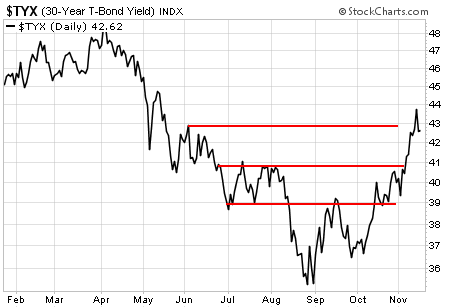 Let the crisis begin.
Let the crisis begin.
In the past week, the yield on the 30-year Treasury bond has popped 43 basis points, or roughly 12%. The U.S. dollar index made a new low for the year earlier this month, but has since rallied 6% in just six days.
Gold and silver have exploded higher. And food commodities are up more than 20% over the past two months.
The Fed has lost control of the bus, and the passengers are waking up just in time to watch it drive off the cliff.
The telltale sign of a budding liquidity crisis is an increase in long-term interest rates. And based on the following chart of the 30-year Treasury yield, the crisis is well on its way…

Interest rates have powered higher over three key resistance levels (red lines). Now that the 30-year yield is above 4.3%, there isn’t any notable resistance to hold it back from running straight up to 4.8%.
[ad#Google Adsense]That will crush the bond market.
Understand… the Fed controls short-term rates. Through its open market operations, buying and selling Treasury bills, the Fed can set its target for the short-term interest rate market. It’s virtually unprecedented, though, for the Fed to be actively involved in the long-term interest rate market.
So long-term rates have always been the best gauge of systemic economic pressures. Of course, that hasn’t been the case since early 2009, when the Fed used the first quantitative easing (money-printing) program to artificially prop up the value of long-term bond prices.
By doing so, it manipulated long-term rates lower, signing a death sentence for the U.S. dollar.
You see… money flows to where it is treated best. It leaves low interest rate environments in favor of countries with higher returns. As money exited the United States and found more comfortable homes overseas, the dollar fell and other currencies rallied.
A weaker currency translates to inflation.
No, the government won’t admit it. The Consumer Price Index is unchanged over the past year, and the Fed continues to dismiss clear evidence of inflationary pressures.
Gold is up 35% on the year. A gallon of milk costs almost 50% more than it did last December. Gas prices are higher. Electricity costs more. Virtually all the items we need to survive have increased in price.
Yes, big screen televisions are cheaper. Cell phone plans are less expensive. And Apple’s products have come down a bit.
But you can’t eat your iPhone.
Make no mistake… There are plenty of inflationary pressures in the pipeline. Not inflation of the things you want, but of the things you need. Those pressures have been masked by the Fed’s participation in the long-term interest rate market.
Until now…
Interest rates are sharply higher over the past few weeks. Despite the Fed’s willingness to manipulate long-term rates, there isn’t enough demand for our bonds from other sources to keep up with the ever-increasing supply.
So bond prices are falling and interest rates are rising. And it’s happening just after mom and pop investors put their entire life savings into the U.S. bond market at record low interest rates.
As I warned in August, this is going to end badly.
Bond investors have already lost 9% in the past two months. That’s how far the iShares Barclays 20+ Year Treasury Bond ETF (TLT) has fallen. Though I doubt Mom and Pop have even noticed it yet. They won’t see their statements for a few more weeks.
How do you suppose they’ll react when they see their “safe” Treasury bonds have fallen in value and it’ll take the next three years of interest payments just to get back to even?
You can send your thank you notes to Fed Chairman Ben Bernanke.
[ad#Google Adsense]Everything the Fed has done since early 2009 was designed to intentionally manipulate security prices higher. Bonds and stocks have enjoyed a tremendous rally, even though nothing has been done to fix the problems that nearly collapsed the financial market two years ago. Those problems still exist. And now, the Fed is running out of magic beans.
Rising interest rates are bad. They’re bad for bonds, bad for stock prices, and bad for commodities. The only thing that goes up in value is the dollar – and gold, though to a lesser extent.
In a liquidity crisis, investors sell off nearly everything in a mad rush to get cash. Need proof? Just look at the first quarter of 2009. Lehman Brothers had just gone belly-up and there was a genuine fear the United States’ financial system was going to fail. Long-term Treasury bond prices fell 14%. The S&P 500 dropped 25%. General commodity prices dropped 17%. And the dollar rallied 10%.
Cash is king in a liquidity crisis. So hang on to yours.
Best regards and good trading,
— Jeff Clark
[ad#jack p.s.]
Source: The Growth Stock Wire
